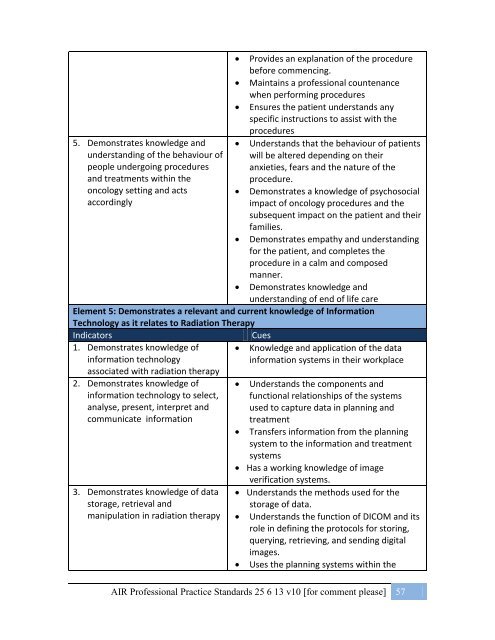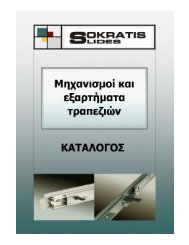Australian-Professional-Standards-Practices
You also want an ePaper? Increase the reach of your titles
YUMPU automatically turns print PDFs into web optimized ePapers that Google loves.
5. Demonstrates knowledge and<br />
understanding of the behaviour of<br />
people undergoing procedures<br />
and treatments within the<br />
oncology setting and acts<br />
accordingly<br />
• Provides an explanation of the procedure<br />
before commencing.<br />
• Maintains a professional countenance<br />
when performing procedures<br />
• Ensures the patient understands any<br />
specific instructions to assist with the<br />
procedures<br />
• Understands that the behaviour of patients<br />
will be altered depending on their<br />
anxieties, fears and the nature of the<br />
procedure.<br />
• Demonstrates a knowledge of psychosocial<br />
impact of oncology procedures and the<br />
subsequent impact on the patient and their<br />
families.<br />
• Demonstrates empathy and understanding<br />
for the patient, and completes the<br />
procedure in a calm and composed<br />
manner.<br />
• Demonstrates knowledge and<br />
understanding of end of life care<br />
Element 5: Demonstrates a relevant and current knowledge of Information<br />
Technology as it relates to Radiation Therapy<br />
Indicators<br />
Cues<br />
1. Demonstrates knowledge of<br />
information technology<br />
associated with radiation therapy<br />
• Knowledge and application of the data<br />
information systems in their workplace<br />
2. Demonstrates knowledge of<br />
information technology to select,<br />
analyse, present, interpret and<br />
communicate information<br />
3. Demonstrates knowledge of data<br />
storage, retrieval and<br />
manipulation in radiation therapy<br />
• Understands the components and<br />
functional relationships of the systems<br />
used to capture data in planning and<br />
treatment<br />
• Transfers information from the planning<br />
system to the information and treatment<br />
systems<br />
• Has a working knowledge of image<br />
verification systems.<br />
• Understands the methods used for the<br />
storage of data.<br />
• Understands the function of DICOM and its<br />
role in defining the protocols for storing,<br />
querying, retrieving, and sending digital<br />
images.<br />
• Uses the planning systems within the<br />
AIR <strong>Professional</strong> Practice <strong>Standards</strong> 25 6 13 v10 [for comment please] 57

















